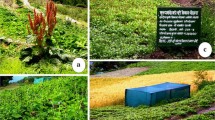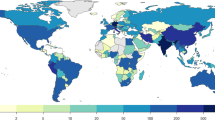Abstract
Medicinal and aromatic plants (MAPs) are an integral part of our biodiversity. In majority of MAP rich countries, wild collection practices are the livelihood options for a large number of rural peoples and MAPs play a significant role in socio-economic development of their communities. Recent concern over the alarming situation of the status of wild MAP resources, raw material quality, as well as social exploitation of rural communities, leads to the idea of certification for MAP resource conservation and management. On one hand, while MAP certification addresses environmental, social and economic perspectives of MAP resources, on the other hand, it ensures multi-stakeholder participation in improvement of the MAP sector. This paper presents an overview of MAP certification encompassing its different parameters, current scenario (Indian background), implementation strategies as well as stakeholders’ role in MAP conservation. It also highlights Indian initiatives in this direction.

Similar content being viewed by others

References
Anishetty M, Tina H (2000) Strengthening of community management for agricultural biodiversity: a way to implement the global plan of action for conservation and sustainable utilization of plant genetic resources for food and agriculture. In: Abstracts of GRCP, Oaxtepec, Morelos, Mexico, October 8–14, 2000. University of California, Division of Agriculture and Natural Resources, Genetic Resources Conservation Program, Davis CA USA
Batugal PA (2004) Inventory and documentation of medicinal plants in 14 Asia Pacific countries. In: Batugal PA, Jayashree K, Lee SY, Jeffrey TO (eds) Medicinal plants research in Asia: the framework and project work plans, vol 1. International Plant Genetic Resources Institute–Regional Office for Asia, the Pacific and Oceania (IPGRI-APO), Serdang, pp 3–6
Bhattacharya P, Prasad R, Bhattacharyya R, Asokan A (2008) Towards certification of wild medicinal and aromatic plants in four Indian states. Unasylva 59(230):35–44
Brown L, Robinson D, Karman M (2002) The forest stewardship council and non-timber forest product certification: a discussion paper. Forest Stewardship Council (Secretariat) Avenida Hidalgo 502, Oaxaca 68000, Mexico
Developing standards for certification of medicinal and aromatic plants in Uttarakhand Winrock India (2009). http://www.winrockindia.org/aromatic_plants-%20in_uttarakhand.htm. Cited 18 Mar 2009
Development of medicinal plants policy brief for sustainable harvest, pricing and trade regime of wild produce within the framework of participatory forest management (2007) Regional Dialogue, IIFM, Bhopal, India
Donovan RZ (2001) Practical conservation through certified forestry. Observations on equity after ten years of smartwood certification. FAO-GTZ-ITTO seminar on ‘building confidence among forest certification schemes and their supporters’. Rome, Italy, 19–20 February, 2001
Durst PB, Mckenzie PJ, Brown CL, Appanah S (2006) Challenges facing certification and eco-labelling of forest products in developing countries. Int Rev 8(2):193–200
Export-Import Bank of India (2003) Export potential of Indian medicinal plants and products. Occasional paper no. 98. Export-Import Bank of India, Quest Publications
Gibb H (2007) Gender dimensions of intellectual property and traditional medicinal knowledge. E-discussion paper, Asia-Pacific Trade and Investment Initiative. UNDP Regional Centre in Colombo, April, p 15
Guideline on good agricultural and collection practice (GACP) for starting materials of herbal origin (2006) The European Agency for Evaluation of Medicinal Products. February 2006. http://www.emea.europa.eu/pdfs/human/hmpc/24681605en.pdf. Cited 18 Mar 2009
Hansen E, Washburn MP, Finley J (2002) Understanding forest certification. http://sfp.cas.psu.edu/pdfs/PS%20Underforestcert.pdf. Cited 18 Mar 2009
International Standard for sustainable Wild Collection of Medicinal and Aromatic Plants (ISSC-MAP) (2007) Version 1.0 Medicinal Plant Specialist Group
Jain AK (2000) Regulation of collection transit and trade of medicinal plants and other non timber forest products in India—a compendium. TRAFFIC—India, New Delhi, India
Jayarajan M (2004) Sacred Groves of North Malabar. In: Neelakandan S, Nair PRG, Shaji H (eds) Kerala Research Programme on Local Level Development. Centre for Development Studies, Thiruvananthapuram
Katiyar A (2007) Group Certification for of organic NTFPs: Dhamtari approach. IDRC – Canada (ICIMOD), NMPB-New Delhi, India and CGMFP Federation – CG
Law W, Salick J (2006) Comparing conservation priorities for useful plants among botanists and Tibetan doctors. Biodivers Conserv 16(6):1747–1759. doi:10.1007/s10531-006-9057-2
Leslie AD (2004) The impacts and mechanics of certification. Int Rev 6(1):30–39
Mallet P, Karmann M (2002) Certification of non-timber forest products: an emerging field. http://www.etfrn.org/etfrn/newsletter/pdf/etfrnnews32.pdf. Cited 18 Mar 2009
Müller S, Dürbeck K (2005) Guidance manual for organic collection of wild plants. SIPPO, Stampfenbachstrasse 85, P.O. Box 492, 8035 Zürich, Switzerland. March 2005. http://www.sippo.ch/internet/osec/en/home/import/publications/food.-ContentSlot-44399-ItemList-93332-File.File.pdf/pub_food_wildplants.pdf. Cited 18 Mar 2009
Pierce AR, Laird SA (2003) In search of comprehensive standards for non-timber forest products in the botanicals trade. Int Rev 5(2):138–147
Pierce A, Shanley P, Laird SA (2003), Certification of non-timber forest products: limitations and implications of a market based conservation tool. Paper presented at the international conference on rural livelihoods, forests and biodiversity, Bonn, Germany, 19–23 May 2003
Rudge J, Hamilton A (2006) Developing organic certification for more sustainable harvesting of wild medicinal plants. http://www.plantlife.org.uk/international/assets/med-plants/IFOAM-May2006.pdf. Cited 18 Mar 2009
Samy RP, Pushparaj PN, Gopalakrishnakone P (2008) A compilation of bioactive compounds from Ayurveda. Bioinformation 3(3):100–110
Schippmann U, Leaman D, Cunningham AB (2006) A comparison of cultivation and wild collection of medicinal and aromatic plants under sustainability aspects. In: Bogers RJ, Craker LE, Lange D (eds) Medicinal and aromatic plants. Springer, Berlin, pp 75–95
Shanley P, Pierce A, Laird S (2005) Beyond timber: certification of non-timber forest products July 2005. http://www.foresttrends.org/documents/publications/Forest%20Certification%20and%20NTFP_7-22-05.pdf Cited 18 Mar 2009
Verma SK (1998) Evolving mechanism for NTFP oriented forest management. For Usufructus 1(1 & 2):1–22
Weber R, Butler J, Larson P (eds) (2000) Indigenous peoples and conservation organizations: experiences in collaboration. WWF International, Switzerland (February 2000)
World Health Organization (2003) WHO guidelines on good agricultural and collection practices (GACP) for medicinal plants. Geneva, 2003. http://whqlibdoc.who.int/publications/2003/9241546271.pdf. Cited 18 Mar 2009
Acknowledgments
Authors acknowledge the financial assistance from National Medicinal Plant Board (NMPB), New Delhi, India. Authors wish to extend their thanks to anonymous reviewers for their suggestions to improve the manuscript.
Author information
Authors and Affiliations
Corresponding author
Rights and permissions
About this article
Cite this article
Bhattacharyya, R., Asokan, A., Bhattacharya, P. et al. The potential of certification for conservation and management of wild MAP resources. Biodivers Conserv 18, 3441–3451 (2009). https://doi.org/10.1007/s10531-009-9653-z
Received:
Accepted:
Published:
Issue Date:
DOI: https://doi.org/10.1007/s10531-009-9653-z



